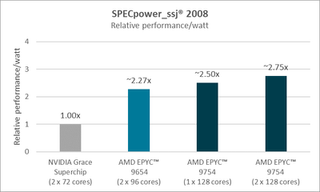
Powerhouse Performance: Gigabyte Integrates Artificial Intelligence Into High-End Workstations, GPUs & SSDs with Advanced AI Software Tools

The Epic Showdown: AMD’s EPYC Processors Vs. Nvidia’s ARM-Powered Grace - Who Wins on Performance? Double the Speed Revealed
When it comes to data center CPUs, Nvidia is a new kid on the block that has to prove that it can develop competitive processors for servers. AMD, an established player, apparently considers Nvidia’s 72-core Arm-powered Grace Hopper Superchip a competitor, which is why it decided to publish ablog that compared the performance of its EPYC processor to Nvidia’s Grace platform in a series ofbenchmarks , claiming up to a 2x performance advantage. AMD also points out x86’s compatibility advantages over chips based on the Arm architecture. While, of course, such a comparison has to be taken with a grain of salt, it gives us some idea about the performance of Nvidia’s Grace CPU.
Based on tests conducted by AMD, its EPYC 9754 (128-cores) and 9654 (96 cores) processors deliver over twice the performance of Nvidia’s Grace CPU Superchip (72 cores) in various workloads, including general-purpose computing, server-side Java, transactional databases, decision support systems, web servers, in-memory analytics, video encoding, and high-performance computing (HPC).
For instance, in the SPECpower_ssj2008 benchmark, single- and dual-socket AMD EPYC systems outperform Nvidia Grace systems by approximately 2.50x and 2.75x, respectively. A dual-socket AMD EPYC 9654 system outperforms a similar Nvidia system by about 2.27x on the same tests, highlighting their superior energy efficiency.

(Image credit: AMD)
AMD says its EPYC processors hold over 300 world records for performance and efficiency across various benchmarks, including business applications, technical computing, data management, data analytics, digital services, media and entertainment, and infrastructure solutions. Still, considering the fact that the main purpose of Nvidia’s Grace Hopper project is to run AI training and inference workloads, not exactly general-purpose server workloads, the results aren’t shocking. However, Nvidia’s Hopper is renowned for its prowess in AI applications.
LATEST VIDEOS FROM tomshardware Tom’s Hardware

(Image credit: AMD)
AMD’s EPYC Zen 4 processors are built on the x86-64 architecture, ensuring compatibility with a wide array of software written for x86 architecture. By contrast, Nvidia’s Grace is based on the Arm architecture, and while Arm is catching up with x86 in terms of data center software support, x86 is still ahead in terms of compatibility.
AMD also notes that due to their high performance, energy efficiency, and compatibility with existing software and infrastructure, AMD’s EPYC processors offer a lower total cost of ownership (TCO) than Nvidia’s Grace.
AMD’s own tests show that its EPYC processors outperform Nvidia’s Grace CPU Superchip across various key workloads, provide extensive compatibility due to their x86-64 architecture, and offer a proven, future-proof solution for diverse data center needs, which is why the company claims they are a better choice for general data center workloads. However, when it comes to AI training and inference, Nvidia’s Grace Hopper platform can offer significant advantages over AMD’s Instinct. After all, AI is what Nvidia’s Grace Hopper platform was developed to address from the start.
Stay On the Cutting Edge: Get the Tom’s Hardware Newsletter
Get Tom’s Hardware’s best news and in-depth reviews, straight to your inbox.
Contact me with news and offers from other Future brands Receive email from us on behalf of our trusted partners or sponsors
By submitting your information you agree to theTerms & Conditions andPrivacy Policy and are aged 16 or over.
Also read:
- [New] In 2024, Marketing Mastery Discerning Real Engagement From Skewed Statistics
- [Updated] Begin Animation Ease-In Transition for 2024
- [Updated] Enhance Your Photos with Top Insta Editors for 2024
- [Updated] In 2024, Mastering Quick YouTube Comment Removal Techniques
- Expert Strategies to Maintain Administrator Mode for Your Applications on Windows 11
- How To Remove Screen Lock PIN On Infinix Note 30 Pro Like A Pro 5 Easy Ways
- In 2024, From Noisy to Pro How to Eliminate Background Noise in FCPX
- In 2024, How To Join Someone’s Live on TikTok as a Guest
- In 2024, How to Remove and Reset Face ID on Apple iPhone 8
- Mastering Adobe Premiere Top 6 Tricks for Professional-Grade Videos
- New Edit Like a Pro 64-Bit Video Editor for Windows 8 and Up
- Take Your Videos to the Next Level 3 Creative Transition Ideas in FCP
- The Apple Watch Series 8 Unveiled: Detailed Guide on Release Timeline, Features, Costs & Latest Updates
- Top Picks: The Ultimate Guide to the Finest 11-Inch iPad Air Protectors
- Updated Adobe Premiere Pro CS6 Mac Download - Latest Update
- Updated Elevate Your Video Editing Top 10 Free Green Screen Apps for Android/iOS
- Updated Free MP4 Video Trimmers Top Picks
- Updated Free Video Editing for Gamers The Best Options
- Updated From Moving to Still A Simple Guide to Freezing Frames in Videos
- Title: Powerhouse Performance: Gigabyte Integrates Artificial Intelligence Into High-End Workstations, GPUs & SSDs with Advanced AI Software Tools
- Author: Giselle
- Created at : 2025-02-17 03:30:54
- Updated at : 2025-02-20 08:37:54
- Link: https://ai-vdieo-software.techidaily.com/powerhouse-performance-gigabyte-integrates-artificial-intelligence-into-high-end-workstations-gpus-and-ssds-with-advanced-ai-software-tools/
- License: This work is licensed under CC BY-NC-SA 4.0.